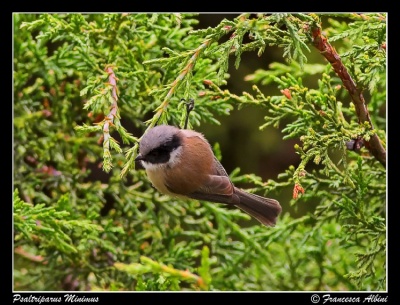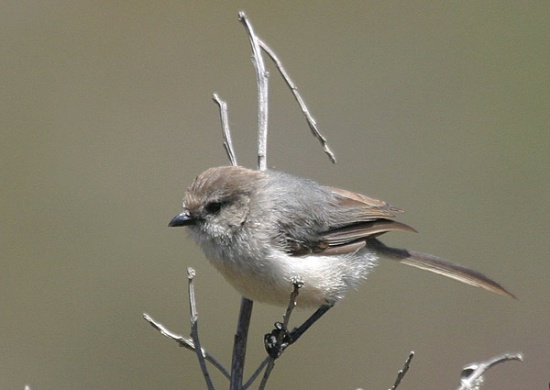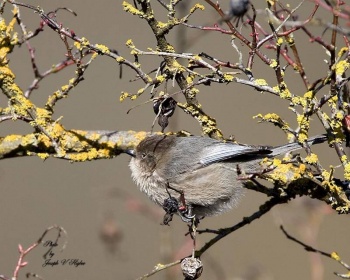- Psaltriparus minimus
Identification
One of North America's smallest birds, other than hummingbirds: 4.5 inches (11 cm) in length, nearly half of which is the long, narrow tail. Weight is only 5.3 g
Eyes are dark in the male, but cream to yellowish in the female.
Coastal birds have brown crowns; interior birds are more gray overall with brown cheeks. Birds from southern Texas southward sometimes sport black masks.

Photo by gatafrancesca
San Cristóbal de Las Casas, Chiapas, Mexico, November 2006
Distribution
Southern British Columbia and far western USA through Mexico to Guatemala.
Taxonomy
Subspecies
The Bushtit has 11-12 subspecies depending on authority[1]:
The forms with black mask (subspecies including at least melanotis and personatus) was formely considered a distinct species, the Black-eared Bushtit (P. melanotis). There is a complex transition zone between this and the northern forms.
Minimus Group (Pacific)
- P. m. saturatus':Southern British Columbia, Puget Sound lowlands and Whidbey Island
- P. m. minimus: Pacific coast west of the Cascades (northern Oregon to southern California)
- P. m. melanurus: Coastal southern California (northern San Diego County) to northern Baja
- P. m. grindae: Mountains southern Baja California (Sierra de la Laguna)
Plumbeus Group (Interior)
- P. m. plumbeus: Eastern Oregon to Idaho, Wyoming, Arizona, New Mexico, western Texas
- P. m. californicus: Interior southern Oregon to southern California (Kern County)
- P. m. sociabilis: Southern California (Little San Bernardino and Eagle mountains)
Melanotis Group (Black-eared)
- P. m. dimorphicus: Mountains of north-western Mexico (Sonora to Sinaloa and northern Coahuila)
- P. m. iulus: Mountains of western Mexico (Durango to southern Jalisco and western Tamaulipas)
- P. m. personatus: Mountains of central Mexico (Michoacán to western Veracruz and Puebla)
- P. m. melanotis: Mountains of southern Mexico (Guerrero, Oaxaca and Chiapas) to Guatemala
A study shows genetic divisions within this species possibly indicating a future split.
Habitat
Chaparral and open woodlands. Especially southern populations are limited to mountains.
Behaviour
These birds roam in flocks, flowing from one tree to the next, keeping the group together with a constant chatter of calls. They are non-migratory, but may move to lower elevations in the colder months. Gregarious except when breeding. Groups are often seen huddled together on nightly roosts to conserve body heat.
References
- Clements, JF. 2011. The Clements Checklist of Birds of the World. 6th ed., with updates to August 2011. Ithaca: Cornell Univ. Press. ISBN 978-0801445019. Spreadsheet available at http://www.birds.cornell.edu/clementschecklist/downloadable-clements-checklist
- Paper describing genetic findings with this species
Recommended Citation
- BirdForum Opus contributors. (2024) Bushtit. In: BirdForum, the forum for wild birds and birding. Retrieved 16 May 2024 from https://www.birdforum.net/opus/Bushtit





